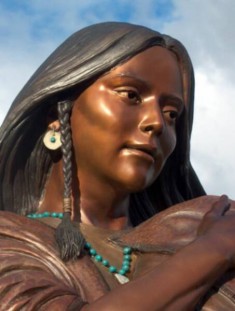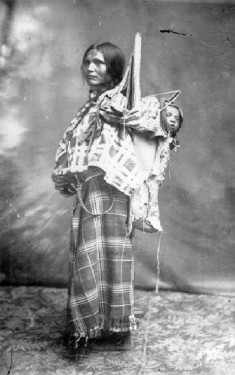The Native American woman Sacagawea, born of the Shoshone tribe, is certainly a remarkable woman in American history. In 1804, she joined the famous expedition of Lewis and Clark. She proved to be a major element both in the success and the survival of the expedition members.
Sacagawea’s Early Years
Because the Indians of the late 18th century kept no written records of births, the exact date or year of Sacagawea’s birth is unknown. However, the most accepted dates are 1788, 1789, or 1790. She was born in Idaho among the Lemhi Shoshone people. When she was approximately 12 years old, she was captured in a raid by Hidatsa warriors and was taken back to live among the Mandan in what is present-day North Dakota.
Becoming a Wife
At the young age of about 12 or 13, she was taken as wife by a French fur trader, Toussaint Charbonneau, who had been living among the Mandan. Some accounts say that Charbonneau purchased Sacagawea, but other stories say he won her as a gambling debt. Sacagawea became pregnant in about 1804, and was still with child when Lewis and Clark arrived at the village where she lived.
Value to Lewis and Clark
Lewis and Clark hired her husband to act as a guide. They quickly realized that Sacagawea would be an invaluable additional member of the expedition because of her ability to speak the languages of the Indians to the west. Sacagawea learned enough French and English to become an extremely versatile member of Lewis and Clark’s exploration team. Her value as such would later prove to be a critical element of the expedition’s success.
Sacagawea gave birth to a son, named Jean Baptiste Charbonneau, in February of 1805, while the Lewis and Clark expedition remained in the winter camp at the North Dakota site. When the group continued its expedition in the spring, Sacagawea traveled along while carrying and nursing a newborn. The baby quickly became a beloved member of the expedition and was nicknamed “Pompy.”
Contributions to the Mission
 Sacagawea proved to be a woman of extraordinary strength, courage, and intelligence. It can be said that she saved the lives of every man on the Lewis and Clark team in a variety of ways, including facilitating tricky diplomatic language with certain Natives, including those that may have been hostile to the white men. But other acts of quick thinking and bravery also stand out.
Sacagawea proved to be a woman of extraordinary strength, courage, and intelligence. It can be said that she saved the lives of every man on the Lewis and Clark team in a variety of ways, including facilitating tricky diplomatic language with certain Natives, including those that may have been hostile to the white men. But other acts of quick thinking and bravery also stand out.
For example, on May 14, 1805, a sudden storm capsized one of the expedition boats. Sacagawea single-handedly recovered a number of valuable supplies, without which the expedition would have been crippled. Her interpretation and negotiation skills later proved valuable in trading for much needed horses among the Shoshone.
On many occasions, Lewis and Clark encountered a wide diversity of tribes and peoples. Her contribution to negotiations with the Nez Perce and intercessions with other hostile tribes were valuable beyond measure.
It can also be said that Sacagawea saved the Lewis and Clark expedition members from outright starvation. When their supplies were depleted to the point that the men had resorted to eating candles made of tallow, Sacagawea showed them how to forage for natural edible plants, including camas roots.
Finally, her very presence among the expedition made many Native American tribes assume that Lewis and Clark were not a war party because warriors never traveled with women — and the fact that she was of the Shoshone was also significant.
Later Life and Death Controversy
Upon the return of the Lewis and Clark expedition in 1806, Sacagawea and her husband resumed their lives among the Hidatsa or Mandan people in North Dakota. She gave birth to a second child, this time a daughter, which they named Lizette.
William Clark had become so attached to Sacagawea’s son “Little Pompy” that he wrote a letter to Sacagawea and her husband offering to take the child into his care in the city of St. Louis. There the boy could be enrolled in school and get a first-class education. The offer was accepted and Jean Baptiste was sent to St. Louis.
In about 1812, Sacagawea reportedly became ill with the “putrid fever” and died in a fort near present-day Mandan, North Dakota. She was about 24 years old at the time. However, other and perhaps more controversial historians contend that Sacagawea did not die in 1812, but she lived to a very advanced age, dying in 1884, when she would have been in her 90s.
While this latter scenario is compelling, Sacagawea is generally considered to have died in 1812.
The Legend of Sacagawea
Sacagawea would later become a significant figure among women, especially among those groups who were fighting for women’s rights and women’s suffrage in the last 19th and early 20th centuries. Her example was held up as a paramount example of female fortitude, intelligence, and remarkable strength.
Sacagawea was honored with an image minted onto a U.S. $1 coin, even though what Sacagawea truly looked like is unknown. No prints or drawings of her exist. The image on the coin was based on a model who was a modern woman and a member of the Shoshone tribe.
